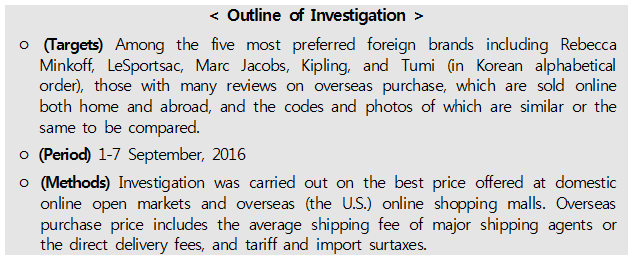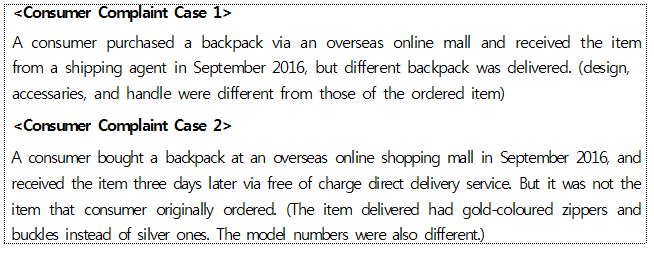KCA News & Media
Press Release
Press Release
| Backpacks under $200 Costs Less through Overseas Purchase, while those above the Price are Less Expensive through Domestic Buying | |||||
|---|---|---|---|---|---|
| Date | 2016-10-12 | Hit | 1704 | ||
|
Backpacks under $200 Costs Less through Overseas Purchase, while those above the Price are Less Expensive through Domestic Buying - Price gap between the two purchasing methods amounts to 62.5% at maximum for same models depending on colours and patterns -
Korea Consumer Agency (www.kca.go.kr) investigated the overseas and domestic prices of the top-10 foreign brand backpacks, which demonstrates that four in six backpacks under USD 200 have lower prices abroad – 4.2% at minimum and 11.6% at maximum – than in Korea. Meanwhile, those priced above $200 (tariff and import surtaxes imposed) are more expensive – 47.5% at maximum – when purchased abroad than in the country. The price gaps broaden depending on colours and patterns even for the same models.
□ Items above $200 with tariff and import surtaxes imposed are less expensive in domestic market Considering high prices of foreign brand backpacks, the duty-free limit (USD 200) was applied for categorising; four in six items under $200 are sold at cheaper price abroad than home, even if the shipping fees are added. Biker backpack from Marc Jacobs and Challenger II backpack from Kipling are 4.2% and 11.6%, respectively, less priced in the U.S. than in korea.
Among four Items that exceed $200 with tariff and import surtaxes imposed, only Mini Julian backpack from Rebecca Minkoff is 4.9% less expensive through overseas purchase than through domestic buying; the rest are more expensive abroad than home, 13.5% at minimum with Rebecca Minkoff’s Julian backpack and 47.5% at maximum with Tumi’s Alpha Bravo Knox.
Furthermore, consumers’ preference on colours and patterns easily changes as backpacks are left out of time at rapid pace. In fact, the investigation indicates that nine out of ten items abroad, and five out of those ten at home have price gaps depending on their colours and patterns. For overseas purchase, the minimum and maximum prices of Voyager backpack from LeSportsac are KRW 63,517 and KRW167,240 respectively, showing 62% price gap. Buying at home has not much difference; Basic backpack from LeSportsac are 68,850 won at minimum and 183,600 won at maximum, or 62.5% price gap depending on its colour or pattern. ※ These ten items have 1 to 97 colour/pattern variety(-ies).
□ Prudent decision needed in case of overseas purchase The KCA suggests to consumers that they should check if the total price of items they want to buy are less than the duty-free limit, consider and compare the features of the products for a certain period of time, and make a discreet buying decision. In particular, the price gaps would be widened in Black Friday season, which should be also taken into consideration.
Moreover, in the case of false shipping from abroad, consumers have to take a partial responsibility even when it is not their fault. As overseas buyers have to bear the costs for return, the KCA recommends that consumers should check the terms and conditions to see if there are any unfair or unfavourable conditions for them before purchasing items overseas. The KCA has been running Cross Border Transaction Consumer Portal (http://crossborder.kca.go.kr) as part of Government 3.0 since October 2015 in order to promote safe overseas purchase and provide consumer damage prevention guidelines and information on tariff, customs clearance, and parallel import. Consumers are recommended to check relevant guidelines on the webpage.
|
|||||
| Next | Senior Citizens Deceived by Sleazy Sales Tactics in a Year Accounts for 23.3% | ||||
| Prev | Memorandum of Understanding between the Korea Consumer Agency and the US Council of Better Business Bureau on Resolving Consumer Damages related to Cross-border Transactions | ||||



